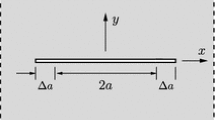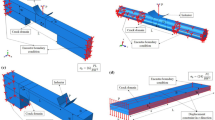Abstract
Scale or size effects in fracture result from the interaction of some energies dependent upon volume and other energies dependent on area (cube-square scaling). The known scaling laws within the lefm and nlefm ranges and within the rigid-plastic range are highlighted along with applications. This paper derives for the first time the scaling laws for elastoplastic fracture based on linear power-law behaviour which span the different regimes from lefm at one end of the spectrum to extensive ductile fracture at the other. The existence of a master-curve of normalised load X vs normalised displacement ū is demonstrated on which fall all results from different size geometrically-similar testpieces up to first cracking. Crack propagation in larger bodies begins at smaller normalised loads and displacements than geometrically-similar small bodies. Large bodies behave as if their fracture toughness were given by (R/λ), where λ(>1) is the scaling factor, rather than by the material value R. Propagation behaviour is path-dependent and each size cracked body has its own X-ū propagation plot. This explains departures from ‘geometric’ (λ3) scaling well-known in the literature. Comparison is made with old and recent experimental results.
Similar content being viewed by others
References
Atkins, A.G. Chen Zhong and Cotterell, B. (1998). The essential work of fracture and J R curves for the double cantilever beam specimen: an examination of elastoplastic crack propagation. Proceedings of the Royal Society of London A454, 815–833.
Atkins, A.G. (1990). Scaling of J R curves. International Journal of Fracture 43, R43-R46.
Atkins, A.G. and Caddell, R.M. (1974). The laws of similitude and crack propagation. International Journal of Mechanical Sciences 16, 541–548.
Atkins, A.G. (1995). Non-proportionally scaled lefm components and the scaling of elastic eta factors. International Journal of Fracture 70, R23-R27.
Atkins, A.G. (1988). Scaling in combined flow and fracture. International Journal of Mechanical Sciences 30, 173–191.
Atkins, A.G. (1975). Ice breaking modelling. Journal of Ship Research 19, 40–43.
Atkins, A.G. (1968). Scaling in ice fracture mechanics: non-proporationately scaled and non-linear behaviour in Ice Technology. (Edited by C. Murthy, J. Connor, A. Brebbia), Berlin, Springer Verlag, 67–75.
Atkins, A.G. and Chen Zhong, (1996). Scaling in elastoplastic fracture mechanics in Size-Scale Effects in the Failure Mechanisms of Materials and Structures. (Edited by A. Carpinteri), (Proc. IUTAM Conference on Scaling, Turin) London, E&FN Spon, 473–482.
Booth, E., Collier, D. and Miles, J. (1983). Impact scalability of plated steel structures in Structural Crashworthiness. (Edited by N. Jones and T. Wierzbicki), Butterworths, London, 136–174.
Brown, W.F., Lubahn, J.D. and Ebert, L.J. (1947). Effects of section size on the static notch bar tensile properties of mild steel plate. Welding Journal 26, 554s-559s.
Docherty, J.G. (1932). Bending tests on geometrically similar notched bar specimens. Engineering 133, 645–647.
Docherty, J.G. (1935). Slow bending tests on large notched bars. Engineering 139, 211–213.
Gurney, C. and Ngan, K.M. (1971). Quasistatic crack propagation in non-linear structures. Proceedings of Royal Society of London A325, 207–222.
Gurney, C. and Hunt, J. (1967). Quasi-static crack propagation. Proceedings of the Royal Society A299, 508–524.
Hagiwara, K., Takanabe, H. and Kawano, H. (1983). A proposed method of predicting ship collision damage. International Journal of Impact Engineering 1, 257–279.
Hu, J.M. and Albrecht, P. (1991). Limit load solution and loading behaviour of C(T) fracture specimen. International Journal of Fracture 52, 19–45.
Irwin, G.R. (1954). The effect of size upon fracturing in Symposium on Effects of Temperature on Brittle Behaviour, ASTM, Philadelphia, 176–194.
Kanninen, M.F. and Popelar, C.H. (1985). Advanced Fracture Mechanics. Clarendon Press, Oxford.
Kumar, V., German, M.D. and Shih, C.F. (1981). An engineering approach for elastic-plastic fracture analysis (NP-1931/1237–1) Palo Alto, Electric Power Research Institute.
Lubahn, J.D. (1955). Room temperature crack propagation and size effect on mild steel. Welding Journal 34, 518s-528s.
Lubahn, J.D. and Yukawa, S. (1958). Size effects in slow notch-bend tests of a nickel-molybdenum-vanadium steel. Proceedings of American Society for Testing and Materials 58, 661–677.
Mai, Y-W. and Atkins, A.G. (1975). Scale effects and crack propagation in non-linear elastic structures. International Journal of Mechanical Sciences 17, 673–675.
Mai, Y-W. and Atkins, A.G. (1978). Crack propagation in non-proportionally scaled elastic structures. International Journal of Mechanical Sciences 20, 437–449.
Miller, A.G. (1988). Review of limit loads of structures containing defects. International Journal of Pressure Vessels and Piping 32, 1–50.
Shearin, P.E., Ruark, A.E. and Trimble, R.M. (1948). Size effects in steels and other metals from slow notch bend tests in Fracturing of Metals, ASM, Cleveland, 167–188.
Stanton, T.E. and Batson, R.G.C. (1921). On the characteristics of notched-bar impact tests. Proceedings of the Institution of Civil Engineers 211, 67–87.
Tada, H., Paris, P.C. and Irwin, G.R. (1973). The Stress Analysis of Cracks Handbook, Del Research Corporation Providence, R.I.
Xia, L. and Shih, C.F. (1995). Ductile crack growth — I. A numerical study using computational cells with microstructurally-based length scales. Journal of the Mechanics and Physics of Solids 43, 233–259.
Author information
Authors and Affiliations
Rights and permissions
About this article
Cite this article
Atkins, A. Scaling laws for elastoplastic fracture. International Journal of Fracture 95, 51–66 (1999). https://doi.org/10.1023/A:1018683830486
Issue Date:
DOI: https://doi.org/10.1023/A:1018683830486




